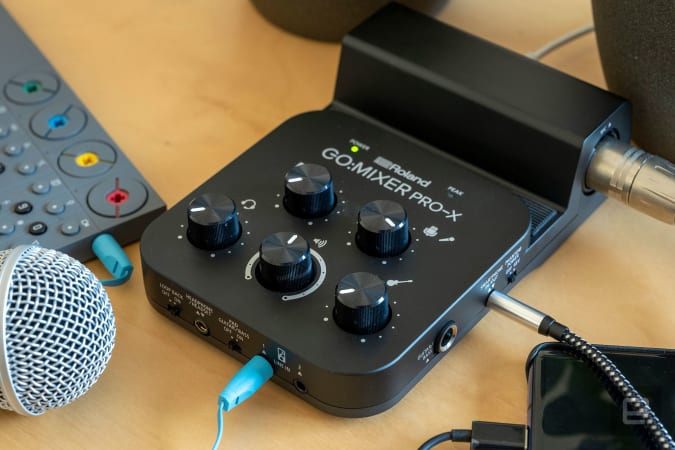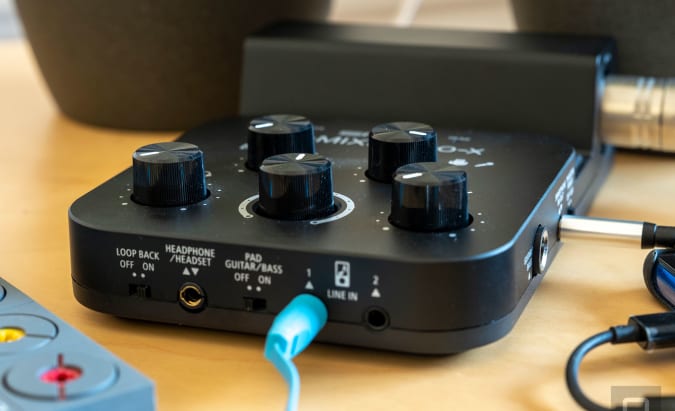Roland’s Go:Mixer series has found a fanbase with musicians looking for a pocket-friendly recording solution — and for good reason. The tiny mixers are lightweight, offer bags of connectivity and won’t break the bank. The latest model, the “Pro-X,” brings some modest but important upgrades from the original Go:Mixer Pro.
The main newness here is less about the audio and more about compatibility: Roland claims the Pro-X adds better support for Android phones and iOS devices. Don’t worry, there is some extra audio functionality. Namely, a new gain “pad” for guitars (to attenuate volume on active pickups) and the headphone/monitor port is now bi-directional (i.e. it’s also an input). Roland pitches the latter as a way to record the inline mic in your headphones, but you can also plug in a lavalier/3.5mm source too, if you can live without monitoring.
The rest of the Pro-X is the same as the Pro before it. There’s a single XLR combi port on the right hand side for microphones and 1/4-inch devices. Also on this side you’ll find the phantom power switch (for when using condenser microphones), a smartphone/line level 3.5mm input and a guitar/bass port. The front edge hosts two more 3.5mm line level inputs, that new pad switch, the updated dual-directional headphone port and the phone loopback switch. The left hand side has just a pair of 1/4-inch instrument inputs and the battery cover for four AAA cells needed for the phantom power.
In short, if it has, or can be converted to, a 3.5mm port, a quarter-inch jack or an XLR connector you can likely use it here.
On the top face of the Pro-X is where you’ll find all the gain rotaries for each input. A few things to note though: the “smartphone” 3.5mm input doesn’t have a gain control, you’ll need to adjust that on the phone itself. Although, you can also plug a phone into one of the quarter-inch ports with an adapter, in which case you will have volume control with one of the ports if that’s important. It’s also worth mentioning that the master volume is also the monitor gain which is a little inconvenient if you want high monitoring levels but low gain on your recording or vice versa.

James Trew / Engadget
Given that the Pro-X has been designed to work with your phone, there’s a handy ridge along the battery compartment that doubles as a slot for your handset. Obviously this means you don’t need to have your phone lying around like a tethered paperweight, but it also provides a good position for the camera should you wish to livestream a performance. My iPhone 12 with a case doesn’t quite fit in the groove perfectly, but enough that the phone is steady when using it.
If there’s one immediate thing I would change, it’s the “peak” indicator. Unlike a DJ mixer where you would have a full strip of LEDs indicating the volume of each channel and a separate one for the master volume, the Pro-X has a single LED that will flash red when any input goes over the maximum threshold (i.e. clipping). It’s quite possible to set your levels so that there’s no red light showing during your checks, and then just one plosive can send it over. If there was a way to constantly see how close you are to 0dB that would be much more helpful.
Worse than that, though, I found that some of my recordings that didn’t trigger the red light could be a little distorted on playback. While speaking into the microphone, everything looked fine, but the recording was often “crunchy” in louder sections. Thankfully, you can actually hear this in your headphones while it’s happening, so you can adjust the levels before hitting record, but ultimately what’s the clipping light for if it’s not reliably preventing you from overdriving things? It made me pretty nervous about each recording until I had experimented with various levels and put more confidence in the monitoring.
After some testing with different mics, it became clear that dynamic mics are fine, but any condenser I tried needed much more headroom to avoid sounding harsh. It’s not clear whether this is a pre-amp or phantom power issue, or just the extra sensitive nature of condensers. When I tested with a Shure SM59 (dynamic/no phantom power), for example, I was able to — in fact almost had to — set the gain to full, and even if the master volume was at 75 percent there was still plenty of headroom.
And that brings us back to the fact that the monitor level control is the same as the master gain. You probably want your levels quite modest to make sure you don’t clip, but in doing so, your monitoring levels are also low, making it harder to hear your mix is how you want it, you know, kinda important things.
I largely avoided this issue by making sure that I was recording into something that showed more detailed levels. Rode’s Reporter app, for example, has a nice, broad meter showing you how hot your signal is and it was much easier to use that as a gauge of the aggregate output.
Teething problems aside, once you’re all set, it’s all very straightforward. Like I mentioned above, I preferred plugging in a phone (or any other 3.5mm source to be fair) via the Guitar port. Having the rotary dial for volume allows you to adjust the volume on the fly much more fluidly, which is handy if you want to use music beds or other such sources where you might want to dynamically alter the volume.

James Trew / Engadget
Likewise, if you want to use two XLR microphones — say for a podcast or a vocal and a mic’d instrument) — you can co-opt one of the 3.5mm ports with something like an iRig Pre 2. This means spending out on another bit of gear, but if you record often, having an XLR-to-3.5mm adapter/interface is pretty handy to have around.
As for that new ability to record with the inline mic on your headphones, all I can say is… it works? Those inline mics are never any good, but it’s never a bad thing to have more inputs, and might work well for more conversational podcasts or just recording phone interviews. As already mentioned, you can actually feed in other inputs here if you don’t need to monitor, say if you’re recording a voice over or something for a multitrack piece you want to edit later.
Perhaps the most interesting thing, for me, is what else can I use this for? Its credentials as a portable mixer for musicians are obvious. But I also feel like it’s just something handy to have around if you work with audio in any way. I’ve become something of an audio-adapter collector. I have all sorts of cables, interfaces and various types of microphones. Something like the Pro-X appeals to me as a simple way to put lots of those together into a portable setup.
The wealth of inputs means it’s pretty flexible, too. That’s a pretty compelling combo right there. The levels issue I mentioned earlier is more about learning how to set things up. Once I figured it out it was rarely a problem after that.
I do wish that the monitor volume was separate from the master volume for those occasions where you really do want to record low but still hear how the mix sounds together. Maybe that’s something we can hope for in a future model.
Whether you’re a garage band, an artist on the move or a podcaster that likes to get out in the big wide world there’s a lot to like here. At $150, it’s also a relatively modest investment for something you can easily fit in your back pocket.
All products recommended by Engadget are selected by our editorial team, independent of our parent company. Some of our stories include affiliate links. If you buy something through one of these links, we may earn an affiliate commission.